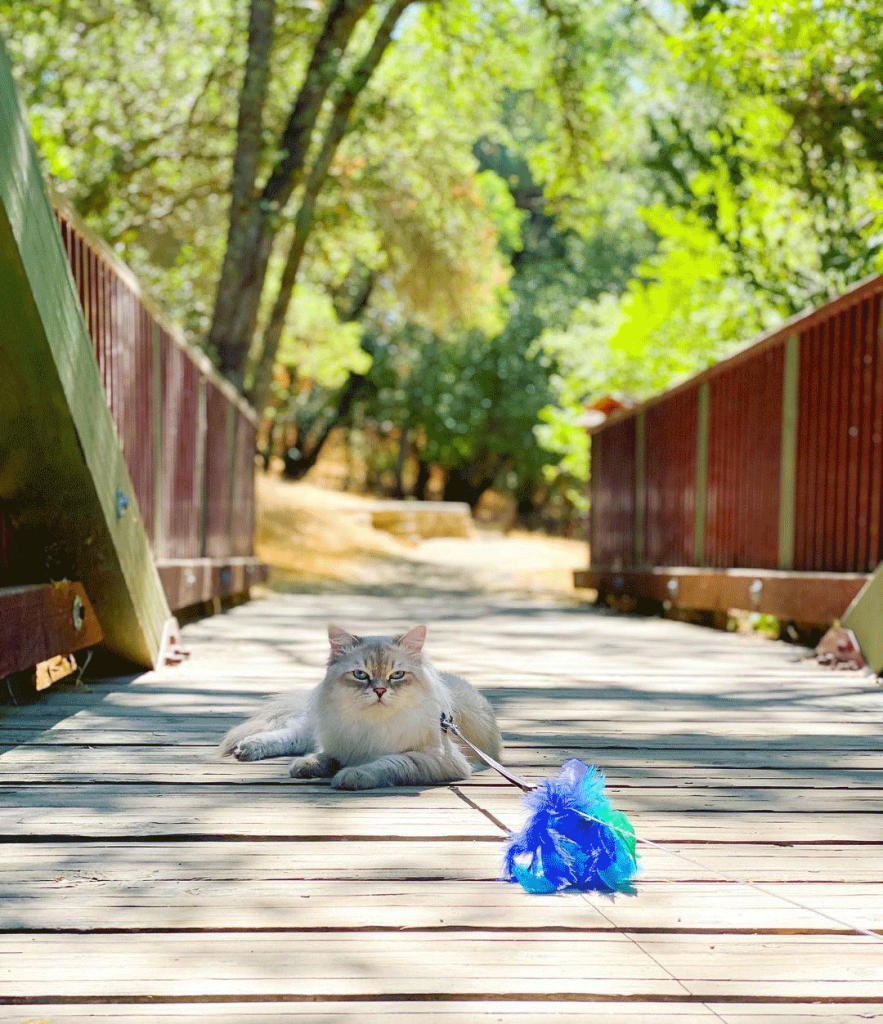From Bowie the Siberian
Want an adventure cat of your own? Or simply looking for fun ways to keep your cat physically and mentally fit?
Here are some tips from Bowie’s mom.
Patience is key.
Let your cat set their own pace, especially when training or going for a walk. Walking a cat is much different than walking a dog. A cat likes to stop, take in all the smells and lay down.
Find out what motivates your cat.
For us, Bowie is very treat-oriented—especially with chicken treats. This can be anything from positive praises to treats to clicker training. Placing treats in puzzle feeders helps stimulate your cat’s brain and enriches their mental health.
Make sure to be prepared when taking your cat outside.
We bring lickable treats to keep Bowie hydrated since he does not like to drink water when outside of the house. We also bring treats, his leash, harness, backpack or bag, a fan or cooling towel during warmer seasons, or a sweater or blanket if it is cooler. We have a GPS tracker on him, he is microchipped, and we have a tag on his harness just in case. We also keep a pet first-aid kit in the car just in case of an emergency.
Your cat should always have a safe-zone.
We trained Bowie to jump in his backpack or bag when he sees a dog or something he is fearful of instead of trying to take off or hide. Bowie feels safe in his backpack or bag because we trained him that way. There can be many dangers when taking your cat out. Always be aware of your surroundings and prioritize your cat’s comfort and safety to avoid any unwanted situations. Practice picking up your cat in a rushed hurry with some key words or phrases. We say “get in your backpack” and Bowie knows to listen and trusts us. You want to practice the rush of picking them up at home first because most cats are frightened when their owner rushes and grabs them. You want to practice this action so it becomes a familiar action for your cat.
Be mindful of the weather.
We do not take Bowie outside when it is too hot or too cold. We do not want to risk adverse health issues such as heat stroke or dehydration. Make sure to feel the ground to ensure it is safe enough for your cat to walk on without burning their paw pads and if they are panting or shivering, please end your adventure immediately.
Consistency when training your cat is key.
Cats have primal reactions to new environments. The more consistently you take your cat on adventures, the quicker your cat’s recovery time becomes. When it comes to primal fight or flight reactions, your cat will naturally express fear when confronted with a loud noise or something unfamiliar. It is your job to comfort them and help them overcome their fears of things like strangers, car noises, and so on.
Try to start out training with quieter spots first.
We started with taking Bowie out on our back patio, then our front yard, then short nature walks, before working our way up to pet stores, coffee shops, and so on. You want to put their comfort first when starting out, especially. Assess your cat’s level of comfort first and foremost and reassure them in soft tones that they are okay and praise them for their courage.
Choose a harness they feel comfortable in.
We tried out vest harnesses in the beginning, and Bowie would just plop. After some research, we realized vest harnesses are very easy to escape out of and that Bowie needed a more minimalistic harness that did not cover his stomach. Cats’ stomachs are extremely sensitive and when something is covering their stomachs, they feel very vulnerable. We found that the custom made, escape-proof harnesses and leashes from the small business SurferCat has been the best option for Bowie. Their leashes have feathers and bells on them to encourage cats to walk with you because they want to follow the feathers and bird noises.



